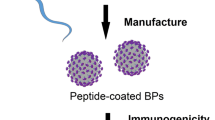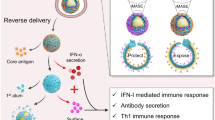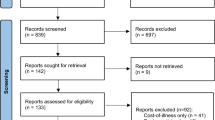Abstract
Infection with group A streptococci can result in acute and post-infectious pathology, including rheumatic fever and rheumatic heart disease. These diseases are associated with poverty and are increasing in incidence, particularly in developing countries and amongst indigenous populations, such as Australia's Aboriginal population, who suffer the highest incidence worldwide1. Immunity to group A streptococci is mediated by antibodies against the M protein, a coiled-coil alpha helical surface protein of the bacterium2. Vaccine development3,4,5 faces two substantial obstacles. Although opsonic antibodies directed against the N terminus of the protein are mostly responsible for serotypic immunity, more than 100 serotypes exist. Furthermore, whereas the pathogenesis of rheumatic fever is not well understood, increasing evidence indicates an autoimmune process6,7. To develop a suitable vaccine candidate, we first identified a minimum, helical, non-host-cross-reactive peptide from the conserved C-terminal half of the protein and displayed this within a non-M-protein peptide sequence designed to maintain helical folding and antigenicity, J14 (refs. 8,9). As this region of the M protein is identical in only 70% of group A streptococci isolates10, the optimal candidate might consist of the conserved determinant with common N-terminal sequences found in communities with endemic group A streptococci. We linked seven serotypic peptides with J14 using a new chemistry technique that enables the immunogen to display all the individual peptides pendant from an alkane backbone. This construct demonstrated excellent immunogenicity and protection in mice.
This is a preview of subscription content, access via your institution
Access options
Subscribe to this journal
Receive 12 print issues and online access
$259.00 per year
only $21.58 per issue
Buy this article
- Purchase on SpringerLink
- Instant access to full article PDF
Prices may be subject to local taxes which are calculated during checkout


Similar content being viewed by others
References
Carapetis, J.R., Wolff, D.R. & Currie, B.J. Acute rheumatic fever and rheumatic heart disease in the top end of Australia's Northern Territory. Med. J. Aust. 164, 146–149 (1996).
Beachey, E.H., Seyer, J.M., Dale, J.B., Simpson, W.A. & Kang, A.H. Type-specific protective immunity evoked by synthetic peptide of Streptococcus pyogenes M protein. Nature 292, 457–459 (1981).
Bessen, D. & Fischetti, V.A. Influence of intra nasal immunisation with synthetic peptides corresponding to conserved epitopes of M protein on mucosal colonisation by group A streptococci. Infect. Immun. 56, 2666–2672 (1988).
Pruksakorn, S. et al. Towards a vaccine for rheumatic fever: identification of a conserved target epitope on M protein of group A streptococci. Lancet 344, 639–642 (1994).
Dale, J.B., Simmons, M., Xhiang, E.C. & Chiang, E.Y. Recombinant, octavalent group A streptococcal M protein vaccine. Vaccine 14, 944–948 (1996).
Kotb, M., Courtney, H.S., Dale, J.B. & Beachey, E.H. Cellular and biochemical responses of human T lymphocytes stimulated with streptococcal M proteins. J. Immunol. 142, 966–979 (1989).
Pruksakorn, S. et al. Identification of T-cell autoepitopes that cross-react with the carboxyterminal segment of the M protein of Group A streptococci. Int. Immunol.. 6, 1235–1244 (1994).
Relf, W.A. et al. Mapping a conserved conformational epitope from the M protein of group A streptococci. Peptide Res. 9, 12–20 (1996).
Hayman, W.A. et al. Mapping the minimal T and B cell epitope within a peptide vaccine candidate from the conserved region of the M protein of group A streptococci. Int. Immunol. 9, 1723–1733 (1997).
Brandt, E.R., Hayman, W.A., Currie, B., Pruksakorn, S. & Good, M.F. Human antibodies to the conserved region of the M protein: opsonisation of heterologous strains of group A streptococci. Vaccine 16, 1805–1812 (1997).
Relf, W.A., Martin, D.R. & Sriprakash, K.S Identification of sequence types among the m-nontypeable group A streptococci. J. Clin. Microbiol. 30, 3190–3194 (1992).
Gardiner, D. et al. Vir typing: A long-PCR typing method for group A streptococci. PCR Meth. Applic. 4, 288–293 (1995).
Quinn, R.W., Zwaag, R.W. & Lowry, P.N. Aquisition of group A streptococcal M protein antibodies. Ped. Infect. Dis. J. 4, 374–378 (1985).
Pruksakorn, S., Galbraith, A., Houghten, R.A. & Good, M.F. Conserved T and B cell epitopes on the M protein of group A streptococci: Induction of bactericidal antibodies. J. Immunol. 149, 2729–2735 (1992).
Robinson, J.H. & Kehoe, M.A. Group A streptococcal M proteins: virulence factors and protective antigens. Immunol. Today 13, 362–367 (1992).
Beachey, E.H. & Seyer, J.M. Protective and nonprotective epitopes of chemically synthesized peptides of the NH2-terminal region of type 6 streptococcal M protein. J. Immunol. 136, 2287–2292 (1986).
O'Brien-Simpson, N.M., Ede, N.J., Brown, L.E., Swan, J. & Jackson, D.C. Polymerization of unprotected synthetic peptides: a view towards synthetic peptide vaccines. J. Am. Chem. Soc. 119, 1183–1188 (1997).
Jackson, D.C., O'Brien-Simpson, N., Ede, N.J. & Brown, L.E. Free radical induced polymerization of synthetic peptides into polymeric immunogens. Vaccine 15, 1697–1705 (1997).
Salvadori, L.G., Blake, M.S., McCarty, M., Tai, J.Y. & Zabriskie, J.B. Group A streptococcus-liposome ELISA antibody titers to group A polysaccharide and opsonophagocytic capabilities of the antibodies. J. Infect. Dis. 171, 593–600 (1995).
Brandt, E.R. et al. Opsonic human antibodies from an endemic population specific for a conserved epitope on the M protein of group A streptococci. Immunology 89, 331–337 (1986).
Ji, Y., Carlson. B., Kondagunta, A. & Cleary, P.P. Intranasal immunisation with C5a peptidase prevents nasopharyngeal colonisation of mice by group A streptococcus. Infect. Immun. 65, 2080–2087 (1997).
Kapur, V. et al. Vaccination with streptococcal cysteine protease protects mice against challenge with heterologous group A streptococci. Microb. Pathog. 16, 443–450 (1994).
Houghten, R.A. General method for the rapid solid phase synthesis of large numbers of peptides: specificity of antigen- antibody interaction at the level of individual amino acids. Proc. Natl. Acad. Sci. USA 82, 5231–5235 (1985).
Coligan, J.E., Kruisbeek, A.M., Margulie, D.H., Shevach, E.M. & Strober, W. in Current Protocols in Immunology Vol. 2 (John Wiley, New York, 1992).
De Malmanche, S.A. & Martin, D.R. Protective immunity to the group A streptococcus may only be strain specific. Med. Microbiol. Immunol. 183, 299–306 (1996).
Acknowledgements
We thank A. Kelso, C. Olive, D. Pombo and L. Powell for reviewing the manuscript. This work was supported by the National Health and Medical Research Council (Australia), the National Heart Foundation of Australia, The Prince Charles Hospital Foundation and the Cooperative Research Centre for Vaccine Technology.
Author information
Authors and Affiliations
Corresponding author
Rights and permissions
About this article
Cite this article
Brandt, E., Sriprakash, K., Hobb, R. et al. New multi-determinant strategy for a group A streptococcal vaccine designed for the Australian Aboriginal population. Nat Med 6, 455–459 (2000). https://doi.org/10.1038/74719
Received:
Accepted:
Issue date:
DOI: https://doi.org/10.1038/74719
This article is cited by
-
Atlas of group A streptococcal vaccine candidates compiled using large-scale comparative genomics
Nature Genetics (2019)
-
Physicochemical characterisation, immunogenicity and protective efficacy of a lead streptococcal vaccine: progress towards Phase I trial
Scientific Reports (2017)
-
Cutting Edge Issues in Rheumatic Fever
Clinical Reviews in Allergy & Immunology (2012)
-
Current status of multiple antigen-presenting peptide vaccine systems: Application of organic and inorganic nanoparticles
Chemistry Central Journal (2011)
-
Novel strategies for controlling Streptococcus pyogenes infection and associated diseases: from potential peptide vaccines to antibody immunotherapy
Immunology & Cell Biology (2009)



